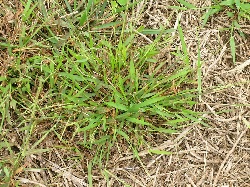ManageSafe
Least-Toxic Control of Crabgrass Choose a different pests

|
Identification
Pest type: Plants
In-depth Information:
Most people find crabgrass to be a familiar weed. Two of the most common species of crabgrass are smooth (Digitaria ischaemum), and large or hairy crabgrass (D. sanguinalis), which are both annuals. Crabgrass grows in a variety of areas, such as lawns, ornamental landscaping, and vegetable gardens. You can find large crabgrass in agricultural areas such as orchards and vineyards. Crabgrass often forms patches in lawns, growing together to form big clumps of the weed. Generally, crabgrass grows in most parts of the U.S., except at high elevations and areas that receive little moisture. It can often be confused with Bermudagrass.
Is it a problem?
Weeds may cause allergies or lead to skin rash on contact. Most weeds are simply a nuisance because they are considered unappealing in a lawn. A few weeds should be tolerated, but weed infestations that overtake turf grass are signs of unhealthy soil.
Pest prevention practices
Foster natural resilience
In-depth Information:
A primary method of control is preventing new infestations. Controlling crabgrass before it sets seed is important, because the seeds can remain viable for at least 3 years in soil.
Having healthy soil, using at least two native turfgrasses, proper watering, and a sensible landscape design can all help your lawn ecosystem develop a natural resistance to weeds. Indeed, crabgrass and other weeds in your lawns are often a sign that the balance of your soils are off. Excessive watering or drought, low mowing height and low fertility tend to promote crabgrass growth, so using proper watering techniques, mowing the lawn above 2 inches, and testing your soil can help you manage weeds in your lawn.
Monitoring and record-keeping
As long as you keep an eye out for crabgrass in your lawn, you should be able to prevent an established and problematic presence. If solitary crabgrass plants are found, they should be removed before seed production starts. Once a few do become established, crabgrass can spread extremely quickly due to rapid seed production. Crabgrass primarily spreads and reproduces by seed, so anything that you do to reduce seed production can help.
Non-chemical and mechanical controls
Mow lawn above 2 inches
Proper watering
Handpick and destroy
In-depth Information:
According to UC IPM:
Fertilizers can increase turfgrass vigor and reduce the possibility of a crabgrass invasion. The best time to fertilize is when the turf is actively growing, which depends upon your turf species. Because seedling crabgrass isn’t very competitive, a vigorously growing turf will crowd out new seedlings.
Irrigation timing and amount also can affect crabgrass germination and growth. Overwatered turf or turf that receives daily, light irrigation becomes weak and vulnerable to invasion by this weed. Irrigating once a week will improve turf vigor. Often, crabgrass first appears in open areas with no turf, along sidewalks where the soil can be warmer, or around sprinkler heads where turf is mowed more closely.
In the landscape, you easily can control crabgrass by mulching, hoeing, and hand pulling when the plants are young and before they set seed.
Mulching with wood products (e.g. wood chips or nuggets), composted yard waste, or landscape fabrics covered with mulch will reduce crabgrass in shrub beds and bedding plants and around trees by blocking sunlight needed for its germination, establishment, and growth. Mulch depth depends on the size of the particles; coarse mulch might need to be 3 to 6 inches deep to control all weeds, while a finer mulch might need to be only 2 to 3 inches deep. Plan to replenish landscape mulches periodically because of decomposition, movement, or settling.
Organic mulches that have been on the soil for a while decomposing can provide an adequate growth medium for weeds to germinate and grow in. If crabgrass is germinating in the mulch, move it about with a rake to reduce seedling establishment. Hand pull escaped crabgrass plants before they set seed. Flaming with a hand-held burner will control crabgrass seedlings, but be careful not to set fire to the mulch if it is wood chips, compost, or another flammable material.
Biological controls
Goats are herbivorous foragers that are very effective at controlling weeds since grass is their least desirable food choice. They can be especially effective for roadside management, along railroad tracks, parks, forests, etc. Many people now make a living by contracting themselves and their herd out for weed control around the nation.
Least-toxic chemical options as a last resort
- Horticultural vinegar, or acetic acid, is also effective at killing certain weeds. Avoid spraying other green vegetation, such as turfgrass, since this is a nonselective plant killer.
- Herbicidal soaps are highly refined soaps that can penetrate the waxy coating on plant leaves, causing them to dry out.
Chemicals to Avoid
Look at your product labels and try to avoid products containing those chemicals listed below:
(A = acute health effects, C = chronic health effects, SW = surface water contaminant, GW = ground water contaminant, W = wildlife poison, B = bee poison, LT = long-range transport)
|
Bensulide Dithiopyr | Oryzalin Pendimethalin | Quinclorac |
Social Media
See what other folks are saying about this, and let us know what works for you.
Controlling Crabgrass: Welcome Back to Question of the Week!Question:I’ve recently moved and am noticing that my...
Posted by Beyond Pesticides on Friday, March 18, 2016
Click the post above to view and comment on Facebook, or comment directly on this site below.








